Admit it. If you’ve traveled on the I-40 or Route 66, you’ve stopped at Exit 50 for ice cream or gasoline. Maybe a corn dog. The tiny ghost town of Ludlow, California is just off these long stretches of roads. You can’t miss it and if you do, you have miles to go before you can turn around. We think Ludlow is the perfect little desert spot in the middle of nowhere. The town boasts two gas stations, a Dairy Queen, a diner, motel and a train maintenance yard. Ludlow is also is home to quite a few abandoned ramshackle houses and countless rusted cannibalized vintage cars. Ludlow even has its own pioneer cemetery. You could say Ludlow has it all. Like many ghost towns, what Ludlow has the most of is a wealth of history. And because it is located right smack dab in the Mojave Desert, there is no shortage of scorching hot days in the summer either, as our spontaneous July sojourn would confirm. The year of 1882 saw the founding of the town of Ludlow, brought about by the establishment of the Southern Pacific Railroad until May 4, 1897 when it became the Santa Fe Railway. This was the main line and connection with Los Angeles.

Nearly a quarter of a century later, in 1900, the Bagdad Chase mine was discovered about ten miles to the south. The railroad to the mine, rich in copper and gold, was called the Ludlow-Southern. The train traveled the road from Ludlow to the mine in about 40 minutes. The living area at the mine was known as Camp Rochester. This camp was often nicknamed “Copenhagen” due to the fact of numerous Danes and Swedes who gathered there to find employment.


For a diner “in the middle of nowhere”, Ludlow Cafe continues to serve up great food and Yelp reviews. In the 1970s it was known as ‘The Friends Coffee Shop.’
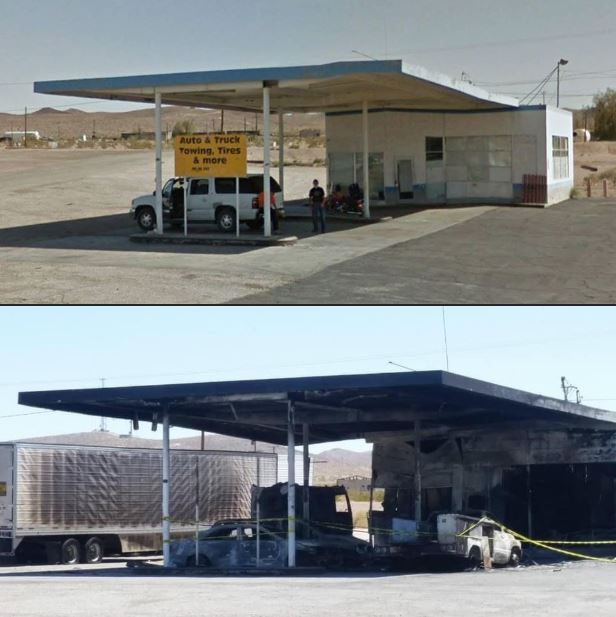
There was a fire at the Ludlow tire shop on July 30, 2020. Apparently a semi truck’s tire caught fire. The story is the driver pulled forward and disconnected the cab but when the truck’s brake line blew the trailer rolled back under the canopy. Here’s the Ludlow Tire Shop before and after the fire. Top photo: Google Earth. Bottom photographer unknown.
Thanks to our friend, author, podcaster, and premiere expert on the Lost Ship of the Desert legend, John Grasson, for alerting us to this situation.

Ludlow became the hub of a thriving community. Workers from the railroads, plus the miners at Camp Rochester soon chose Ludlow for their amusement and entertainment. Ludlow was the “water stop” for all steam engines. Water was found here but proved to be too salty for overall use. So water was hauled by train tank cars from Newberry (later known as Newberry Springs) to permanent tanks in Ludlow. A complete railroad shop was built in Ludlow with housing for the employees. Later, a school and church were constructed.

“I lived in Ludlow in the forties as a kid, and knew everyone in town. Went to school in the still standing school house that was later converted to a residence. Jack Sheridan was the bus driver who took the older kids in to Barstow to every school house. His wife, Vernie, was the postmistress.” Mike L. McNeill

In 1905, the Tonopah and Tidewater Railroad was started mainly for transportation of ore from Beatty, Nevada. This line transported mixed baggage and included a passenger car. W.W. Cahill was superintendent and lived aboard his private car on a line in Ludlow. He used this car for administrative offices. The presence of Cahill and his crew, plus all the railroad workers and miners from Bagdad, created much activity around Ludlow, which became the junction and headquarters for all the surrounding area.

“THE PENDERGAST MOTEL WAS OWNED BY VENUS MCNEILL WHO MARRIED PENNY AND THEN GOT HIM APPOINTED BY POWERS IN SAN BERNARDINO TO THE CONSTABLE’S JOB. VENUS WAS MY DAD’S COUSIN. HER FATHER WAS THE SANTA FE SECTION FOREMAN AND LATER, THE TRACK SUPERINTENDENT ON THE TRACK BETWEEN THERE AND NEEDLES.” MIKE L. MCNEILL



The first school contract was signed August 10, 1905. Cliffie Hoffman, the first teacher, received a salary of $60.00 dollars a month. A tent structure, with board walls half-way up was the first schoolhouse. There were six original pupils. Later, the attendance reached 40, with two teachers.

A United States Post Office was founded in 1902. Originally called Stagg, in the honor of an engineer on the Tonopah & Tidewater Railroad, this office was officially changed to Ludlow in 1926. The post office was discontinued in 1974.

Lee Yim was the only Asian businessman located in Ludlow. He was a cafe owner and operated a barber shop in the same building. He raised a family of 9 children, 8 of whom were graduates of Barstow High School. Note: Our research revealed there was another Asian businessman in Amboy by the name of Lee Yim, or more commonly known as Bill Lee or Bill Yim. Bill and his war bride, Hilda, owned a cafe and Texaco filling station in Amboy. This was about 5-7 years before Roy’s Cafe. In the mid-1930s Bill Yim’s Texaco was the only building on the north side of the road in Amboy. Bill grubstaked prospectors and he had financial interests in some mines in the area. Bill and Hilda had one daughter, Dorothy. The Lee family remained in Amboy until 1957 when Bill retired and moved to Barstow. But I digress.
In 1913, Ludlow consisted of two blocks of business establishments. Contained within this area were two general merchandise stores, three cafes, a pool hall, a barber shop and two rooming houses.



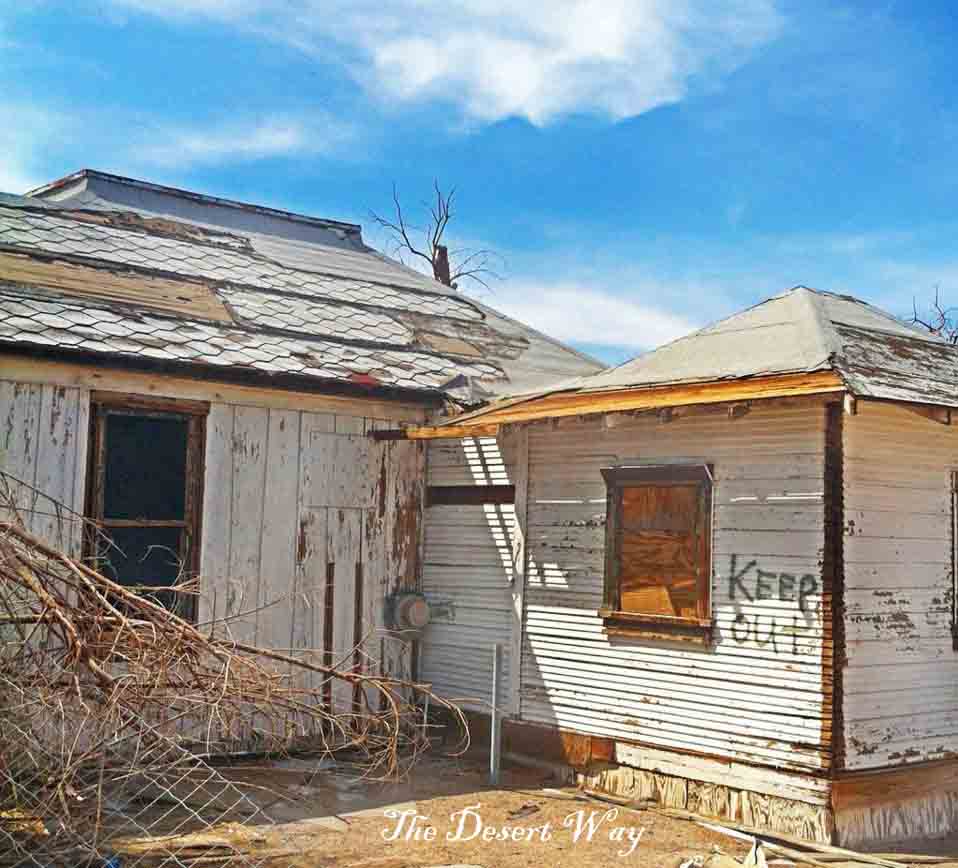


The Murphy brothers, originally from Tecopa, were prominent Ludlow residents. Tom had a store and cafe in Ludlow while Mike conducted a like business in Tonopah.

The brothers had an acrimonious business relationship with Mathilda “Ma” Preston which resulted in accusations of battery and a civil lawsuit, which Ma won. Ironically, she later sold her store to the Murphy brothers before leaving town. For more about the infamous Ma Preston, known as the Queen of the Desert, please read our story at https://www.thedesertway.com/mathilde-preston/



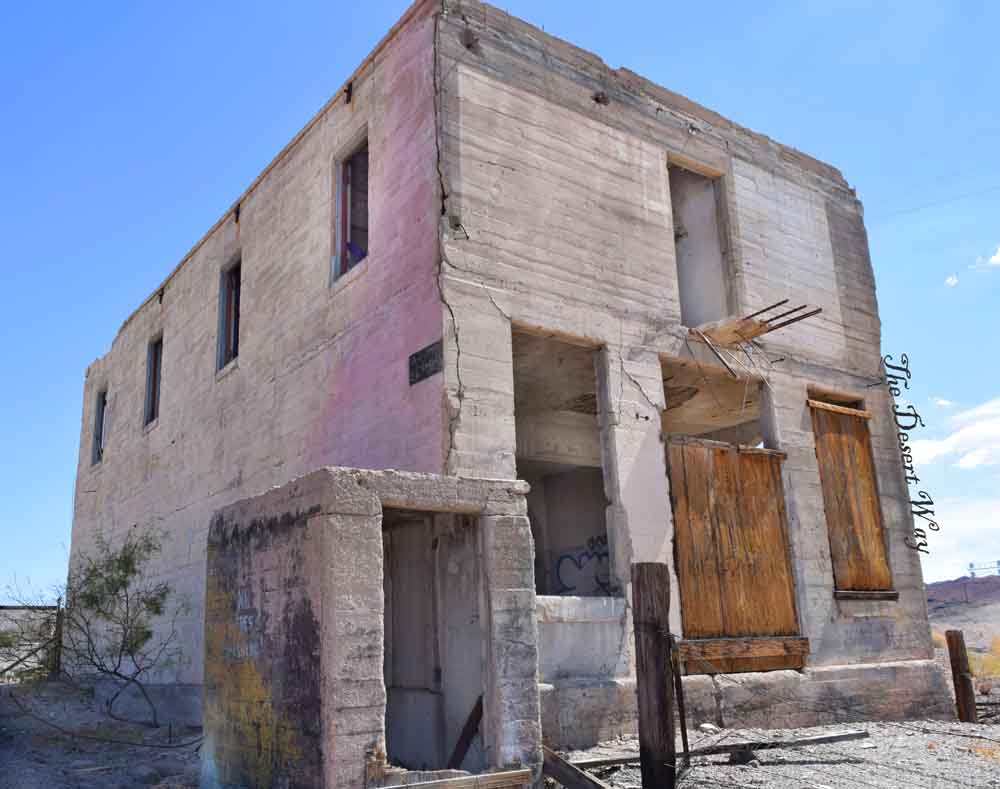




In 1915, there was a cross country automobile race from Los Angeles to Phoenix, Arizona. People from Death Valley came to Ludlow to view the race. Barney Oldfield was the main attraction, being the top auto racer in the nation. The entire day was like a county fair.

Ludlow continued to prosper and through World War I, the Tonopah & Tidewater Railroad remained in operation on its now 250 mile route. However, on June 14, 1940, it ceased all runs.

During its peak years, Ludlow’s population was about 500 people but after the T & T ceased operating the population dwindled to a mere handful of permanent residents.

In 1962, the Cameron Friend family purchased the town site. Lack of water still made living in Ludlow very costly. So, Cameron Friend “water witched” the area. A well was drilled and good water was found at 650 feet down. Today there are three wells producing good water in Ludlow. The Friend family continues.


Ludlow is a ghost town of two era’s; it was also a rest stop for weary travelers along Route 66, National Trails Highway. Interstate 40, also known as Needles Freeway, was built in the 1970s.

PROJECT CARRYALL
In 1962, the Atchison, Topeka and Santa Fe Railway began planning a new railway between Needles and Barstow through the Bristol mountains in California. The straighter, more level route would be 15 miles shorter than the old line, shaving 50 minutes off the trip. But getting through the mountains would require either drilling a tunnel or excavating a new pass; the railway judged the cost of doing either with conventional means to be prohibitive. So, in December of 1962, the Santa Fe Railway contacted the US Atomic Energy Commission (AEC), to ask if the job could instead be done with hydrogen bombs. The excavation program’s primary objective was digging a sea-level replacement for the Panama Canal. The California Department of Public Works (DPW) was also planning a new road through the area to shorten US Highway 66, and they joined the project as well. The AEC, DPW, and the railway together published a feasibility study in November of 1963 proposing to use 23 nuclear bombs, totaling 1,830 kilotons, to blast the new pass through the Bristols. They called the plan Project Carryall.

Twenty-two devices of 20 to 200 kilotons yield would be set off 340 to 780 feet underground. The explosions would remove 68,000,000 cubic yards of earth, creating a roughly parabolic cut 11,000 feet long, 360 feet deep, and from 600 to 1,300 feet wide. A final 100-kiloton device would dig a drainage crater to hold rainwater runoff from the new pass. The California highway division dropped out of Carryall in September of 1966, unwilling to wait any longer. Projects Buggy and Schooner were finally fired in 1968. The biggest project, Galley, a five-bomb row charge blast that would be almost a rehearsal for Carryall, never took place. The Carryall project was never formally shut down, but the study was put on hold in 1965, and its last official mention was in May of 1970. The Plowshare excavation program itself terminated in 1975. The new pass was eventually dug by more traditional means. Whew!




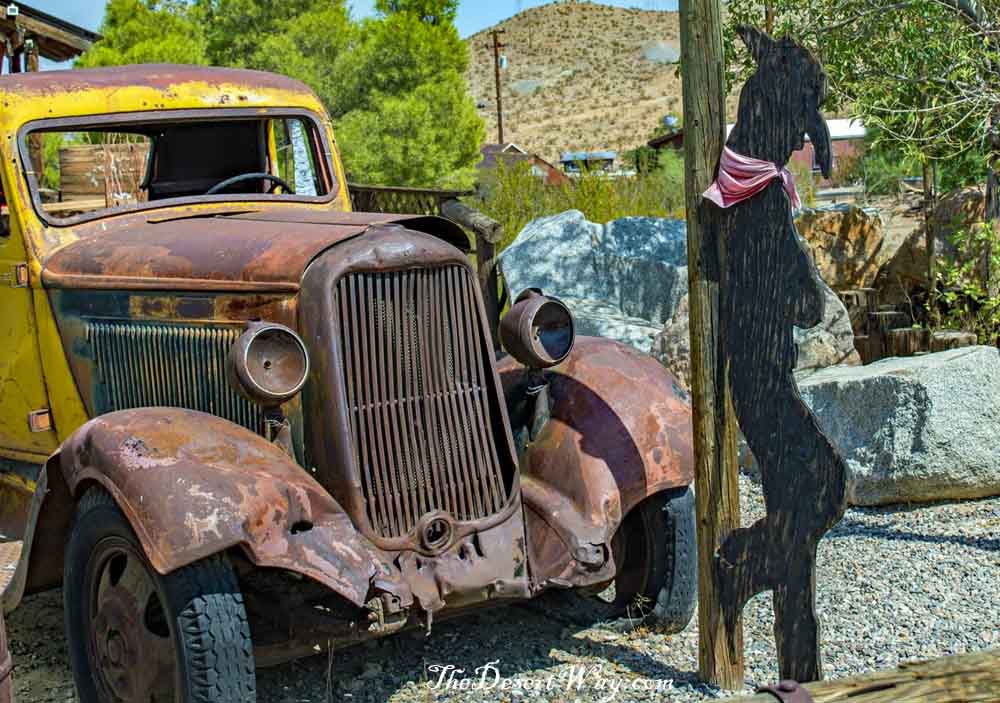
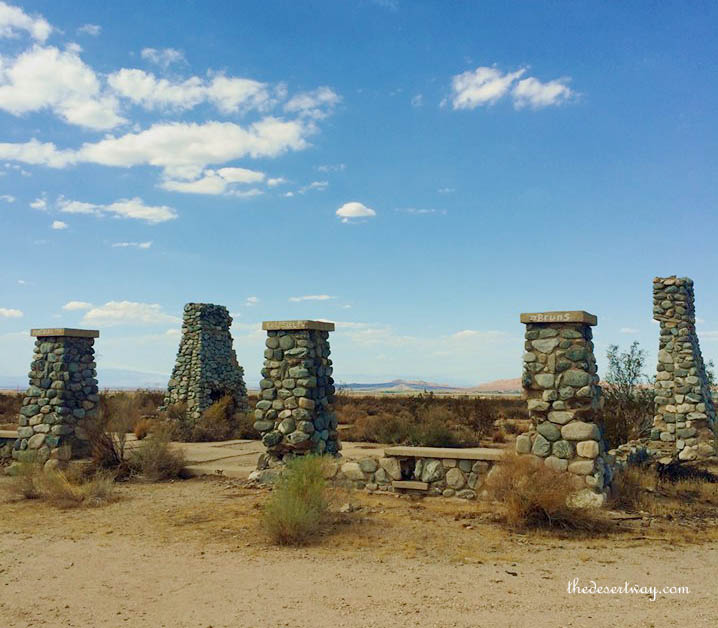
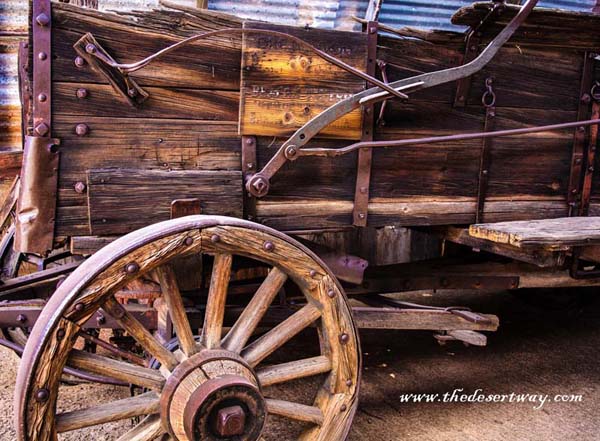
Great write-up of Ludlow! We live in Kingman, AZ and have stopped a few times. Going to have to set aside a couple of hours to explore more after reading this. Never know of Plowshare program. Fascinating.
Thanks so much, Rob. We appreciate your comments. We will be doing a write-up of Kingman in the near future. Have fun!
Wonderful article. I lived in Ludlow in the forties as a kid, and knew everyone in town.Went to school in the still standing school house that was later converted to a residence. Jack Sheridan was the bus driver that took the older kids in to Barstow every school house. His wife, Vernie, was the postmistress. The Pendergast motel was really owned by Venus McNeill , who married Penny and then got him appointed by powers in San Bernardino to the constables job. Venus was my dad’s cousin. Her father was the Santa Fe section forman , and later the track supt. on the track between there and Needles. Let me know if you want some more info…..
Wow, how interesting, Mike! Thanks for pointing out details we were unaware of. I will add them to the main article. Please shoot us more info to our email if you don’t mind…
jearl.thedesertway@gmail.com
We so very much appreciate your comments and help.
Very interesting and informative article. Thank you
Mike:
My name is Paul Villalobos, I am the son of Jose and Esperanza Villalobos. The family lived in Ludlow from January 1949 to January 1951. My Dad was assigned as the Section Foreman during that time, my four sisters and 2 brothers were still kids when they lived there. I am going on a road trip through the Mojave and I am documenting the places my folks lived from the 30’s to the 50’s. Do you have any specific information on where the ATSF Section house was located. The census says it was on Main st 100 yds to the right. I imagine this is along the railroad right of way. Old pictures I’ve found seem to corroborate this but there is no way of telling if these are the Section house and depot. please e-mail me at pvillalo@hotmail.com with your reply if you get a chance. Lee Yim and Bill Sheridan are on the same Census Page as my family in the 1950 census.
Here is my contact infor
As one turning 62 in a couple of weeks, I long for the “good old days”. So much has changed. My mother, who passed in 1993, and I went to “Friends Cafe” several times. Seems like we went before it was even “Friends”. As I sit watching Andy Griffith and how life in Mayberry is so much better than.some places today, I wondered if “Friends” was still there. It is. Wonderful! I really enjoyed your article, it was poignant and brought back such memories of days gone by. Thanks.
You’re right, Charlene. Things nowadays sure are different. It sounds like you have maintained your wholesome values though, and the world certainly can benefit from that. Thanks for sharing!
I was trying to find info on what looks like a ranch home? behind the dairy queen. They had a awsome donkey in the land by the parking lot. Any info on that building?
Wow!. I use to live in Ludlow back when I was between the ages 6-8(i think) maybe younger..around 1975. We lived in the santa fe housing(i think thats what they were) across the tracks, my grandpa worked for the railroad. My little sister & I use to ride the school bus to newberry springs. Wow it seemed such a long ride. I went back in 2011 with my children, to show them where I grew up and moved out to yermo after grandpa retired from the santa fe railroad. I remember the Friends Coffee shop. My older brother worked as a dish washer there. We played all over ludlow, the cemetary, the mining areas, old homes, tree house in the middle of the santa fe housing(I wish i had some old pictures of the santa fe housing)just a memory. Oh geez I can go on and on. I remember the hot french fries served at the Friends coffee shop, served up in a basket…that was a treat for us, only thing we would order and spend our money on. So many good memories there. I had to take my own kids there, too see what it was like to be a real kid & have fun. The desert was our playground:) Wow I can go on forever. A memory sparked LUDLOW, so here i am . Will soon visit again….thanks for reading. grandma & grandpa RIP thanks for raising us. luvya
Desert Girl:
I replied to Mike Mcneil about the Santa Fe Section house in Ludlow, do you remember about where it was in relation to Murphy’s store?
Hi there its been awhile since I’ve been on this page. The Santa Fe section housing was east of the cemetary. It was a long U shaped building facing each other & the restrooms & showers were in the center of the complex seperate building. It was housing with only 2 bedrooms per unit, it was all
cement walls & floors. I remember their was a trash dump almost right behind the section houses, toward the south. There was a tunnel east of the housing we use to crawl through if the train was stopped to catch the school bus. We went back that year with the family it was all gone:( I have a few pics in the background of the section houses. This was sometime in the 70’s. We went to school at Newberry Springs elementary school. I looked everyone on the internet to find more pics of the section housing, can not find. Thanks for reading.
Very interesting. Welcome back, desert girl! Thanks so much for sharing your memories with us. Please feel free to post your photos or reach out by email at thedesertway1@gmail.com
Great story. I also lived in Ludlow in late 40’s and early 50’s with my parents and sister. Went to the Ludlow School and lived in the state yards. My aunt and uncle lived there before we did. Watched the Murphy Store burn along with all of the town people. Remember most of the people you mention especially Lee Yim who always gave me sister and me a piece of sugar cane to chew on
Sounds like it was an amazing place to grow up. Thanks for sharing your story, Judy.
Here is another missing piece of the puzzle picture. Around 1940, according to my mother June Blankenship, her sister Laura Blankenship married Michael Murphy. Michael Murphy died soon after and Laura inherited his properties, and so their father – Elgie Blankenship – moved to Ludlow with June and his wife Jennie in order to help Laura run the store, garage and cafe. Here is my Mom’s accounting of her time in Ludlow:
“Another event changed my life. My father gave up his secure job with Standard Oil to take over what amounted to most of a town fifty miles east of Barstow that had belonged to my older sister’s husband who had died rather suddenly. He was much older than my sister and she was left with owning most of this Route 66 highway stop called Ludlow, California. It consisted of a café, motel, car repair garage, service station, general store, small hotel, a few houses, a diesel power plant, a water system served by water deliveries from Santa Fe Railroad tank cars, and a small Catholic Church built by my sister’s departed husband, Michael Murphy, who had emigrated from Ireland and would bring the Priest out from Barstow periodically. San Bernardino County is as big as some states and there were no county services in Ludlow. The population consisted of employees of my family, employees of the Santa Fe Railroad track maintenance, miners working in area gold mines, a Chinese family who had a tiny store next to the railroad station and sold snacks to the train crews, and an ever changing assortment of desert characters. Ludlow had been an important stop on the migrations of families from the dust bowl to California. They always asked “How far is it to Bakersfield?” where they hoped to find work in the fields. They were continuing to arrive in the period before we entered the war. Their cars were usually 1930’s vintage and often were on their last “legs”. There were usually several hungry children and when they saw big stacks of pancakes come out of the kitchen of our café, their sad, tired faces lit up. The father was especially glad when he saw that he could get a stack of pancakes for 35 cents with generous containers of butter and syrup on the table. There were times however when they could not afford even pancakes and the father would buy a loaf of bread and some baloney at our store and they would sit under the one big tree on the property and make a meal. I lived in Bakersfield in the late sixties and seventies and was pleased to note that many of our neighbors were from Oklahoma and Arkansas. I wondered if they had come on that long journey in the 30’s and possibly had stopped in Ludlow for pancakes. The other patrons of our roadside stop were Greyhound Bus passengers. “The Greyhound” was an important cross country transportation in those days. We were a main stop and provided food and rest day and night. As the war heated up our clientele changed dramatically. There were constant convoys traveling Route 66. Soldiers were being trained in the harsh desert between 29 Palms and our area. We were warned that a bus load was going to stop and we would furiously make sandwiches and pass them out wrapped up for 25 cents as the soldiers lined up. I worked in the various businesses when not in school. It was very hard to find employees who would stay. These were very uncertain times and able bodied men were in the service or working in what we called “defense plants”. Women as well were taking jobs in factories. Cars had a way of breaking down out there in that remote part of the Mojave Desert, often because of overheating. Mechanics would come and go. We asked few questions about their past and I wondered why these wanderers were wandering. If they could fix cars we hired them. Occasionally a traveler would just abandon a car because he had no money and would depart on “The Greyhound” never to be heard of again. My first car was a 1940 Ford convertible, black with leather seats, that someone just left and my Dad had the mechanic fix it up for me. I thought I was so cool.”
How interesting, David! Thank you for sharing your amazing memories for all of us to enjoy.
I have a lot more of old Ludlow type stuff that i got in a box I inherited from the holdings of Venus and Penny Pendercast. Venus was a old cousin type who died back in the sixties. Lots of poetry, from the old lady and history of the connections of the Champion Santa Fe McNeill family. her dad was section forman at Ludlow and then Roadmaster on the desert run, Always enjoy your stuff. And seeing my name and past information. Let me know what is a good mailing address for you and I’ll send you the stuff. You’ll enjoy it.
Thanks so much, Mike! We sure appreciate your kindness and generosity and sent our address to your email. Again, thank you for sharing information about Venus and Penny!
Wow! I lived in Ludlow from the mid-60s to 1972. I was about 6 through 11 years old. I remember Cam Friend and Luther. Dad worked for Cam and Luther owned the gas station on the north side of town. I watered Luther’s trees at his home when he planted them. Dad was the mechanic and tow truck driver. I spent many hours in the Ludlow garage working with dad or going out on breakdowns, accidents, etc. I also remember taking the bus into Newberry Springs, and on my third day of school,, on the way home the bus driver fell asleep and rolled the bus into a dry wash. Luckily no one was seriously injured. I also remember a tornado during that time which did a job on the trailers across 66 from the garage. I do remember it being hot!! On the other side of the tracks lived the Navajo, who worked for Santa Fe. They would spend part of the year in Arizona on the reservation as well. Mom left dad in 1972, just as I-40 was being completed between Ludlow and Needles. Long lost memories. Thank you for the in-depth look.
HI there this is desert girl. That was part of us the navajo who lived across the tracks. But we would spend our time in New mexico & harvest & stay in NM for about 4 months then return for work & school. One side of the section house was us. The family that lived on the east end were from Arizona the Spencers.
My grandpa worked for Santa Fe RR for a very long time. There was a tool house where the tool truck would return & watch all the workers return home. Just near that tool house there was a home, the Mesa’s lived there. I think Connie & Joe Mesa they had a few kids. Thank you for mentioning the Navajo way cool you remember. thanks for reading!
Thanks so much, desert girl!
Wow, I really enjoyed reading this article, plus all of the comments! I’ve never even heard of Ludlow before. I came across this article while looking for alternative routes from Gilbert, AZ to Sonoma County, CA when I bring my mom to live with us. I saw that I-10 was showing a “closed route” warning, so figured we could head north. Ludlow would be about our 1/3 of the way stop. Now I know we can stop at the cafe and also get ice cream!
Thanks everyone for the great photos and stories.